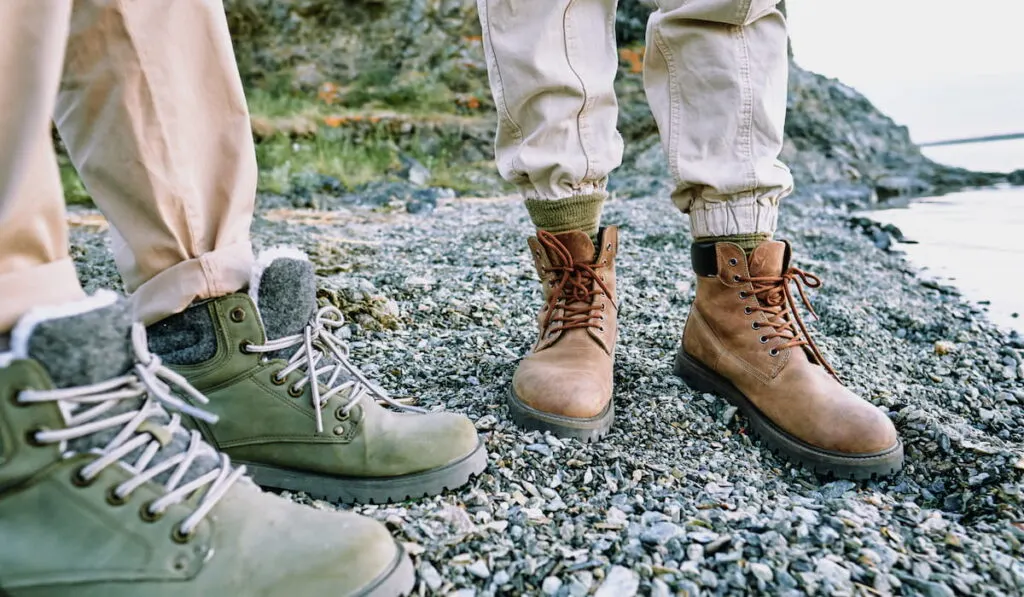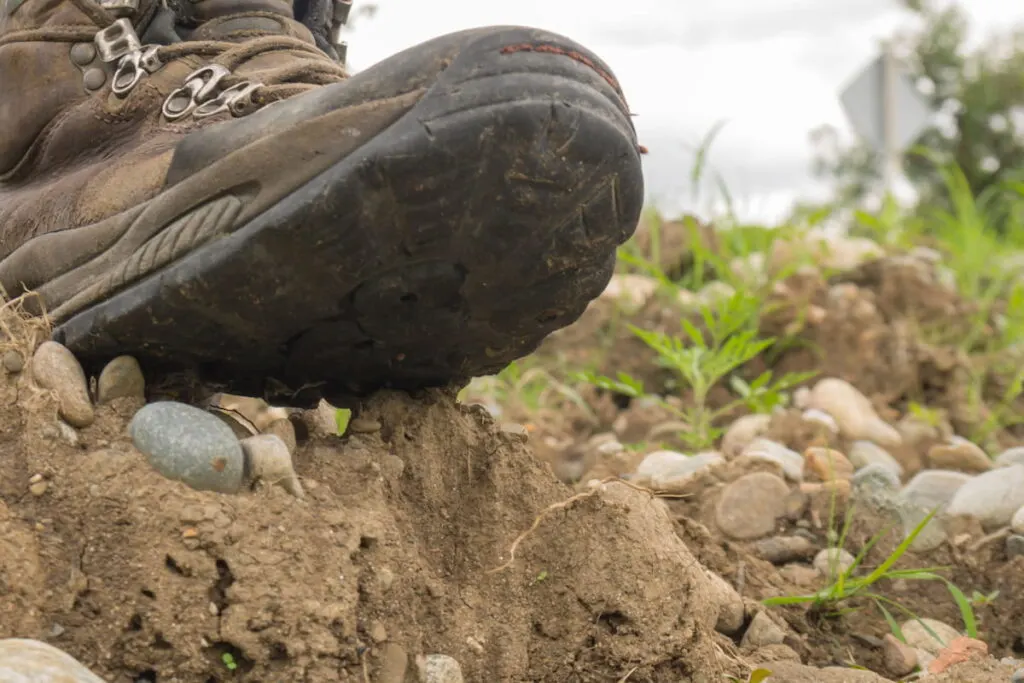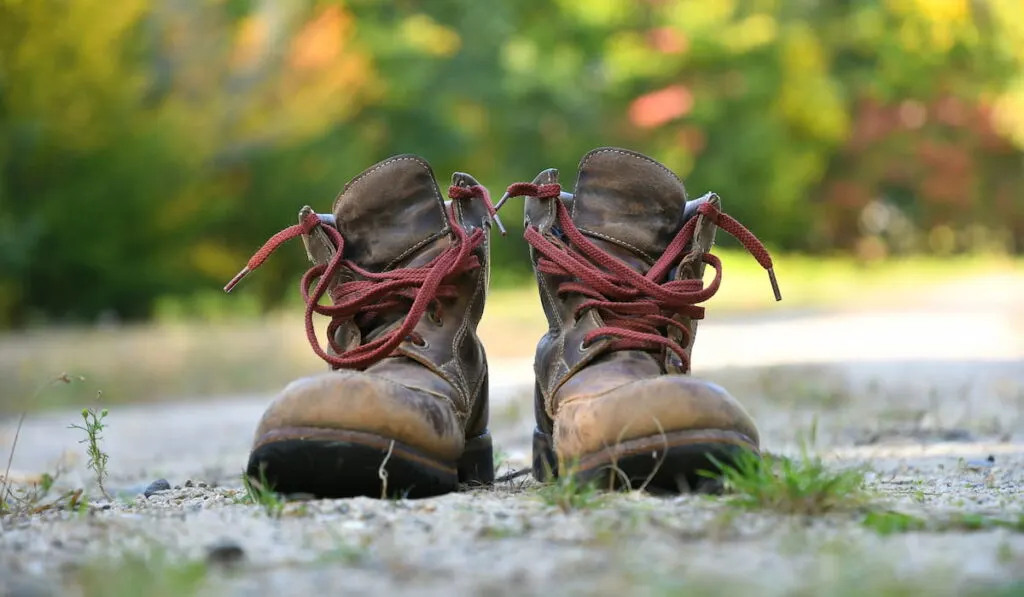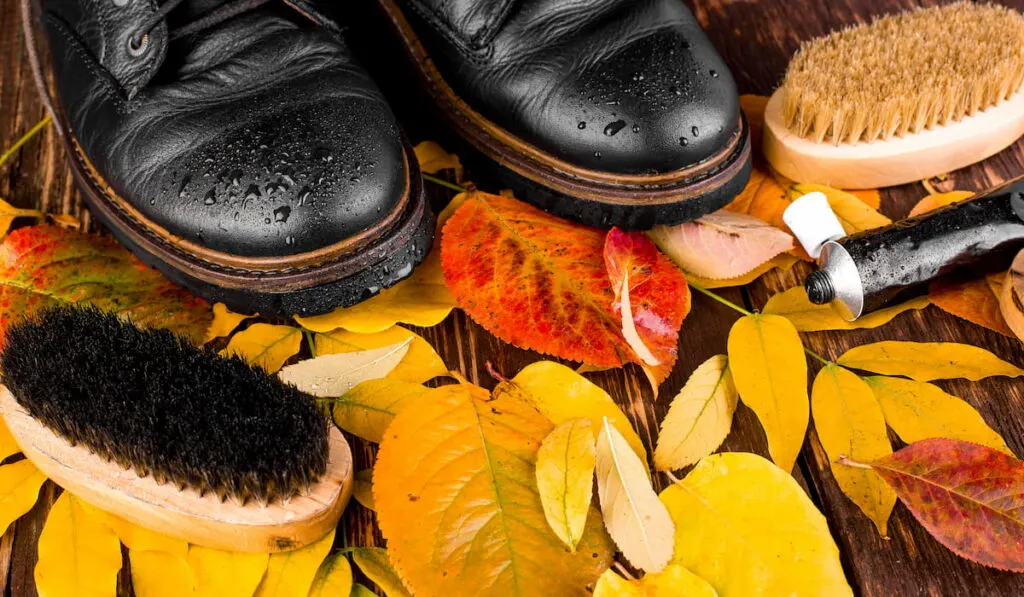Hiking boots are shoes built to last, provide ample support for long trips, and protect your feet from external elements you may encounter when traversing different terrain. These boots, especially from brands like The North Face and Timberland, can last for years despite being costly.
Most hiking boots can last between 500-900 miles, but some can go up to 5,000 miles. Longevity depends on factors like build quality, materials, hiking conditions, maintenance, and the number of miles you hike.

You may need to replace your hiking boots if you notice signs like frayed laces, worn treads, cracks, discomfort, and some sole issues.
Our detailed guide covers telltale signs to look out for when to replace your hiking boots. We also give tips on caring for your new boots to ensure they last.
Table of Contents
8 Signs That It’s Time to Replace Your Hiking Boots
Hiking boots come in handy when navigating different types of terrain, but when should you start budgeting for a new pair?
Apart from soles peeling or cracked leather, there are other signs to look out for, including:
1. Discomfort and Pain
Although an improperly sized hiking book can lead to foot pain and discomfort, sometimes you may also experience the same if you’ve been wearing a comfortable pair for a long time.
You’ll likely experience pain in your feet if the boots have worn out treads and insole. You may first notice that your feet slide in the shoe, or your ankles may lack enough support, leading to stress on your joints.
You may need to get a new pair if you notice that your skin is chafing or blistering in unexpected places or if you experience random pains on your feet, ankles, or hips.
2. Frayed Laces
Your hiking boots are exposed to various elements when walking in different terrain. They must go through dirt, mud, water, and other items that tend to rub your laces.
Additionally, the laces experience constant pulling, tugging, and picking, making them wear out.
Failure to clean your boots and laces properly means that the laces end up stiff and prone to cracking.
Sometimes your laces can still get frayed with proper care. Check your laces often for the plastic wrap at the end. You can expect your laces to unravel and split over time if it’s not there.
Although you can replace the laces, it’s also an indication that your boots need an upgrade as they’ve started to age.
3. Worn-out Tread

A worn outsole tread is another indication that it’s time to replace your boots.
Most hiking boots have moderate to deep tread patterns. That provides traction and grip when hiking in all weather conditions.
Your tread pattern will vary depending on your body type and hiking pattern. For example, you may notice that some parts of the sole are more worn out than others.
If you lift your hiking boots and notice slick soles that are thinned out and filed down, you need to replace them, as worn-out treading can put you at risk of injury.
4. Cracked Midsole
Hiking boots have a midsole, which is the part that provides support and cushioning.
Midsoles absorb the impact on your joints and contribute to overall shoe comfort.
Like regular shoes, hiking boots lose their cushioning after everyday use. The midsole may crack due to compression lines that develop.
You may find your hiking boots uncomfortable to wear for an extended period if they have a worn-out midsole. There’s a chance of developing blisters, and you might experience foot pain after hikes.
The press test is an excellent way to determine whether the midsole is compressed or still intact.
Simply place your thumb against the bottom of the shoe tread pattern and press upwards into the midsole. Boots with heavy compression lines on the side need to be replaced.
5. Rips, Cracks, or Tears on Exterior Fabric
Hiking boots manufacturers take time to create durable shoes that have quality fabric and stitching. Quality boots will have a unique stitching pattern to uphold the boot’s durability.
If you notice that your hiking boots have separated or frayed stitching, you need to consider replacing them. Worn stitching can interfere with your boot’s waterproofing capabilities.
6. Worn Out Insoles or Ankle Support
Does walking with your hiking boots feel like stepping on soil clumps? That’s an indication of worn-out insoles.
Although most hiking boots are made of EVA foam, a durable material, the material is prone to wear and tear after extended use.
Unfortunately, worn-out insoles contribute to foot blisters and reduced ankle support. That’s because the shape of the insole puts your foot off balance and hinders ankle support, leading to joint pain.
Check your hiking boots for fine cracks on the insole and pitting around the ball of your foot. Those are signs that it’s time to replace your boots.
7. Deformed Shape

You need to replace your hiking boots if they look lopsided, deformed, or broader than usual. Deformed boots create stability problems and can lead to falls and injuries.
Checking the ankle collar makes it easy to tell if your boots are worn out. That’s the upper part that wraps around your ankle. The ankle collar may have noticeable cracks or evident signs of wear.
Get yourself new boots if you see these signs.
8. Leaking Boots
Some hiking boots have waterproofing features. If you notice that your boots aren’t as waterproof as they were when new or they’ve started leaking, you may want to consider getting a new pair.
While you might use a waterproofing spray, it’s only a temporary fix and won’t solve the problem. It will only add some days of use.
Caring for Your Hiking Boots
A quality pair of hiking boots can last for six months. Heavy-duty boots can last longer, especially if you hike on easy routes.
Although factors like the terrain you hike on, frequency of your hikes, and quality of your boots affect their longevity, caring for your hiking boots can help extend their life.
Here are a few tips on how to take care of your hiking boots to ensure they last.
Clean After Use

Cleaning your boots with warm water and a soft brush can improve service life.
Applying care products for full-grain leather and suede also ensures the boots don’t absorb much water and dry faster after washing.
Allow your boots to dry away from direct sunlight after cleaning them. Avoid using heat sources to dry the boots, as this can cause the fabric to dry out quickly and crack.
Use a Waterproofing Spray
A waterproofing spray keeps water out of your hiking boots, which helps them last longer.
Final Thoughts
Hiking boots from reliable brands can last 500-900 miles, depending on the hiking terrain, your body type, material, frequency of your hikes, and maintenance.
If you start noticing loose eyelets, a cracked midsole, worn-out insoles, unusual pain after hikes, or worn treads, those are signs that you need to replace your hiking boots. Knowing when to replace your boots can help you avoid discomfort and unnecessary pain.
Resources
- https://hikingladyboots.com/signs-you-need-new-hiking-boots/
- https://www.outdoor-expedition.com/activities/hiking/when-to-replace-hiking-boots/
- https://www.trycrawl.com/common-questions/when-should-you-replace-your-hiking-boots-keep-your-feet-happy-and-healthy-on-the-trail
- https://housershoes.com/blog/14-signs-you-need-new-hiking-shoes/
- https://hikeauthority.com/when-to-replace-hiking-boots/
- https://rmkshoes.com/when-to-replace-hiking-boots/
- https://bootworld.com/blog/how-long-do-hiking-boots-last.html

